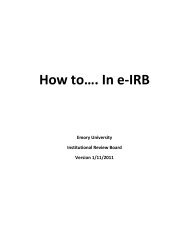A Manual for Participants in Clinical Trials of Investigational Agents ...
A Manual for Participants in Clinical Trials of Investigational Agents ...
A Manual for Participants in Clinical Trials of Investigational Agents ...
You also want an ePaper? Increase the reach of your titles
YUMPU automatically turns print PDFs into web optimized ePapers that Google loves.
5 Phase 2 <strong>Trials</strong><br />
5.1 New Agent Development Considerations<br />
5.1.1 Plann<strong>in</strong>g and Coord<strong>in</strong>ation <strong>of</strong> Phase 2 <strong>Trials</strong> by CTEP<br />
As a sponsor, DCTD must devise and implement plans <strong>for</strong> phase 2 trials <strong>of</strong> novel<br />
therapeutics. An adequate phase 2 plan, while conceptually straight-<strong>for</strong>ward, is <strong>of</strong>ten<br />
difficult to execute. A reasonable plan presupposes answers to the follow<strong>in</strong>g questions:<br />
• What doses and schedules emerg<strong>in</strong>g from phase 1 ought to be carried <strong>for</strong>ward<br />
<strong>in</strong>to phase 2<br />
• What diseases should be targeted <strong>for</strong> test<strong>in</strong>g<br />
• How does the new agent fit <strong>in</strong>to CTEP's priority list <strong>for</strong> various targeted disease<br />
studies<br />
• How does the new agent fit <strong>in</strong>to the priorities <strong>of</strong> the cl<strong>in</strong>ical <strong>in</strong>vestigators who<br />
<strong>for</strong>m the core <strong>of</strong> the NCI-supported cl<strong>in</strong>ical trials network<br />
• How can the CTEP assure that each agent is adequately tested <strong>in</strong> each disease<br />
that is studied How many studies should be mounted <strong>in</strong> each disease category<br />
What k<strong>in</strong>ds <strong>of</strong> patients are suitable <strong>for</strong> study entry What are suitable stopp<strong>in</strong>g<br />
rules <strong>for</strong> phase 2 trials<br />
• How should we per<strong>for</strong>m phase 2 studies if there are limited supplies <strong>of</strong> the new<br />
agent<br />
• What important laboratory correlates can be made with<strong>in</strong> the context <strong>of</strong> a cl<strong>in</strong>ical<br />
trial<br />
• How can the proposed study be completed with<strong>in</strong> a suggested timel<strong>in</strong>e (i.e.<br />
multicenter vs. s<strong>in</strong>gle center)<br />
CTEP staff collaborates with each agent’s <strong>in</strong>dustrial sponsor and the <strong>Investigational</strong><br />
Drug Steer<strong>in</strong>g Committee (IDSC) dur<strong>in</strong>g late phase 1 to plan phase 2 development;<br />
CTEP announces the plan via solicitation <strong>of</strong> LOIs.<br />
5.1.2 S<strong>in</strong>gle Agent Phase 2 Studies<br />
A phase 2 study:<br />
1. determ<strong>in</strong>es whether an agent has antitumor activity and<br />
2. estimates the response rate <strong>in</strong> a def<strong>in</strong>ed patient population.<br />
Well-designed phase 2 trials limit enrollment to just the number <strong>of</strong> patients needed to<br />
ensure detection <strong>of</strong> a medically significant level <strong>of</strong> activity.<br />
Phase 2 studies are disease-oriented. Various tumor types are tested <strong>in</strong> phase 2 as<br />
dist<strong>in</strong>ct cl<strong>in</strong>ical entities, as each has differ<strong>in</strong>g prognostic factors, eligibility requirements,<br />
and patterns <strong>of</strong> responsiveness to a particular agent. As there may be many unknown<br />
or uncontrollable factors contribut<strong>in</strong>g to variability <strong>in</strong> outcome, CTEP attempts to sponsor<br />
two phase 2 trials <strong>in</strong> each tumor type.<br />
The goal <strong>of</strong> these <strong>in</strong>itial phase 2 trials is to determ<strong>in</strong>e whether the new agent has activity<br />
aga<strong>in</strong>st particular cancers. These trials, there<strong>for</strong>e, serve as a screen <strong>for</strong> further study.<br />
For this reason, <strong>in</strong>vestigators must make every ef<strong>for</strong>t to avoid false results. Although<br />
false-positive results are certa<strong>in</strong>ly undesirable, false-negative phase 2 results are also<br />
damag<strong>in</strong>g, as they may delay significantly or prevent discovery <strong>of</strong> a potentially useful<br />
antitumor agent.<br />
Section 5 - Investigator’s <strong>Manual</strong> 2009 18




